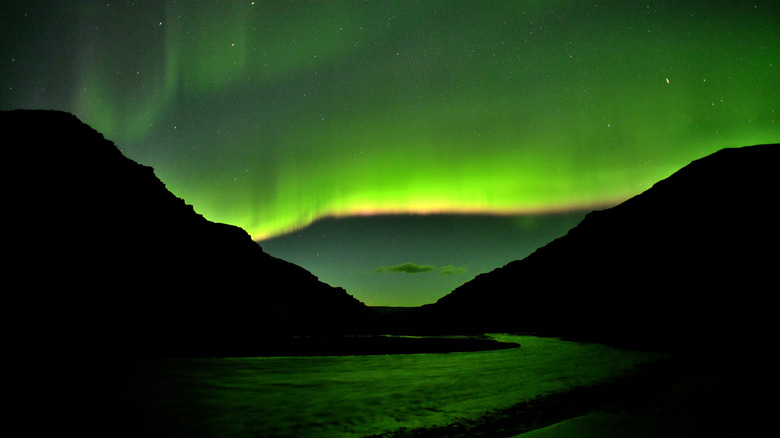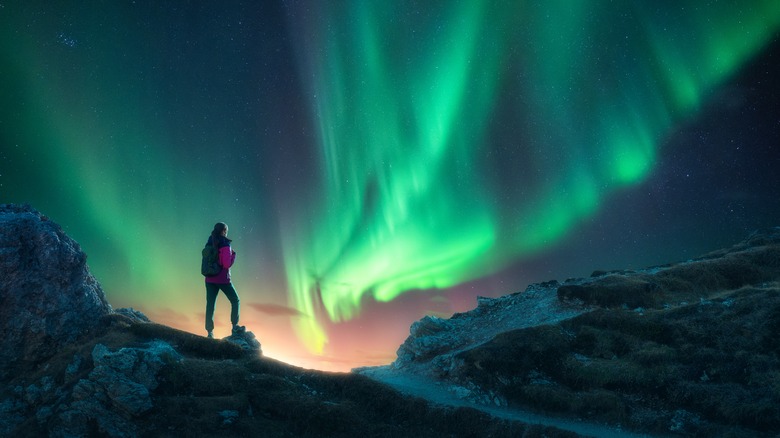Kaitlyn Rosati
You don’t need to travel to Iceland, Norway, or remote parts of the world like Svalbard and Greenland to catch sight of the Northern Lights. You can see them right here in the United States of America, and one of the best states to do so is in Alaska. Traveling to Alaska is an exciting way to feel like you’re visiting somewhere worlds away without ever whipping out your passport. To see the Northern Lights, you’ll want to plan your trip between late August and mid-April.
Northern lights in Alaska, like anywhere else in the world, are best seen in cloudless, dark skies. Use Aurora tracker apps like Aurora Forecast to determine your probability of seeing the Northern Lights on any given day. While it’s possible to see them during darkness, which is up to 24 hours a day in Alaskan winter, prime aurora borealis viewing hours are typically between 10 p.m. and 2 a.m. Your likelihood of seeing the Northern Lights will also depend heavily on where you are in the state.
Where in Alaska to see the Northern Lights?

Mlharing/Getty Images
Alaska is the largest U.S. State (yes, even bigger than Texas), so simply saying to “go to Alaska to see the Northern Lights” is not enough information. Certain cities leave a higher probability than others regarding Northern Lights viewing.
Fairbanks is a great choice since it’s easily accessible. There’s an international airport (FAI), so, with the correct timing, you could see the Northern lights on your very first night in Alaska. Unlike many towns and municipalities where the Northern Lights are visible, Fairbanks is a bustling city, so if you run out of luck and don’t see the lights due to poor weather conditions, you won’t be bored with the plethora of restaurants and bars in town.
If you want to get out of the city, there’s no arguing that one of the most unique places to visit in the world, as well as see the Northern Lights, is Utqiagvik, formerly known as Barrow, Alaska. Utqiagvik is located a whopping 320 miles north of the Arctic Circle and sees, on average, 67 days of total darkness between November and January. Safe to say, if you visit this remote town, which is the most northern town in the USA, there’s a good chance you’ll see the Northern Lights.
How to photograph the Northern Lights

Denis Belitsky/Shutterstock
Capturing the flickering Northern Lights beauty is not the easiest of tasks, but it is possible with the right camera and settings. If you plan to use a phone, you’ll need to ensure you have an app suitable for capturing photos at night. One of the best is NightCap, which has settings for long exposure in low light and even a designated setting, “Stars Mode,” designed to capture the Northern Lights.
If you’re not using an iPhone camera and instead have a SONY, Nikon, or Canon, you’ll want to first set your camera to manual mode. Then, you’ll want to set your focus to infinity or the furthest your focus setting goes. You’ll then want to open your camera’s aperture as wide as it goes and select the lowest possible shutter speed. Set a high ISO value to 2,000 or higher, and take a few test shots to determine if you need to set the white balance to automatic or not. With either a proper camera or a phone camera, you’ll want to edit your photos to make them pop as much as possible, ideally in Lightroom. Hey, pics, or it didn’t happen, right?

